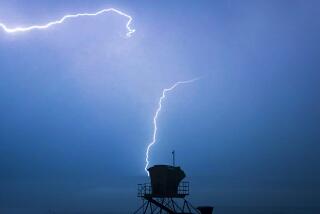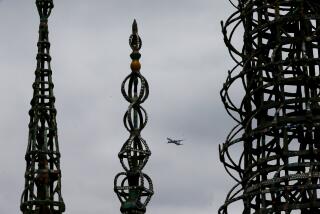Region’s Weather Slightly Wetter
- Share via
Southern California’s weather remained true to form during the last meteorological season -- July 1, 2002, to June 30 -- yielding mostly sunny days and warm temperatures, yet producing slightly wetter conditions than the previous season.
According to the data, weather conditions across the region were warm and dry for most of the season with the exception of higher-than-average rainfall in late winter and early spring.
In keeping with its legendary endless summer weather pattern, the average temperature for downtown Los Angeles was a balmy 65 degrees in 2002-03, just a few notches higher on the thermometer than the 64.84 average temperature the season before, according to the Western Regional Climate Center in Reno.
Rainfall was up slightly across the region in February and March, with 17.01 inches falling in downtown Los Angeles compared with the normal average of 14.79 inches, weather observers said.
“There was a little above normal rainfall, but nothing spectacular,” said climatologist Jim Ashby of the Western Regional Climate Center. “Some months saw extreme rainfall, but when you take all 12 months together, it was not an unusual year overall.”
In Orange County, rainfall totals tripled at Santiago Peak, Villa Park Dam and Costa Mesa, and were four times higher in downtown Santa Ana than the previous season, but the rising rainwater only brought the cities close to their average precipitation levels, according to the Watershed and Coastal Resources Division.
Although Orange County farmers and water officials accustomed to drier-than-normal seasons saw the rain as a bonus, fire officials said the rain was not enough to soak older, thicker vegetation, but fed the growth of newer, lighter grass.
“It’s like if you wadded up newspapers and put branches under wood,” Orange County Fire Capt. Stephen Miller said. “It burns so quickly.”
Firefighters are bracing for a potentially dangerous brush fire season in the Angeles and Cleveland national forests, where hills saturated with water have produced vegetation that can become highly combustible as temperatures rise.
Fire officials have warned campers going to the mountains for the Fourth of July holiday weekend that fireworks are prohibited and those caught using them could face six months in jail and a $5,000 fine.
A massive infestation of bark beetles have left thousands of dead or dying trees that could become fuel for brush fires in heavily wooded areas of Riverside and San Bernardino counties, fire officials said.
“The fact that they are dead trees [means] they’re not only going to burn, but they could have an almost explosive effect and cause the fire to expand much more rapidly than it normally does,” said Mike Huddleston, fire investigation supervisor for the San Bernardino County Fire Department.
To prevent a potential hazard, officials from both counties sought and received a $3.3-million federal grant to pay for tree removal, Huddleston said.
Ventura County farmers say heavier rains produced increased crop yields because surface water did not begin to dry up until early June. Citrus and other tree crops, which require more water than other plants, also are poised to benefit from this year’s longer-lasting wet topsoil.
A three-day storm in May that dumped 3 inches of rain on the region was a boon to farmers. “That was enough to eliminate a month of irrigation for many people,” said Earl McPhail, Ventura County agricultural commissioner, who said local farmers dubbed the onslaught the “$4,000 rain.”
*
Times staff writers Hanah Cho in Riverside and Andy Olsen in Ventura County contributed to this report.
More to Read
Sign up for Essential California
The most important California stories and recommendations in your inbox every morning.
You may occasionally receive promotional content from the Los Angeles Times.













